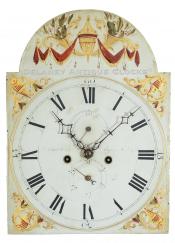Ezra Kelley of Dartmouth, Massachusetts. An outstanding inlaid mahogany case tall clock. 223076.
We have owned and seen a total of three tall clocks that Ezra Kelley signed as the clockmaker. This example is the best of the three. What makes this example so special is the complexity of the inlay display. A similar clock is pictured in Harbor & Home on pages 255-256. All three clocks must have been made by the same hand. These cases are thought to have been constructed by Elisa Cushing, Jr. of Hingham, MA. Elisa lived in Hingham on Main Street in a house his father built. Elisa's Son Theodore was also a cabinetmaker. This very attractive example is constructed in mahogany and features light-line inlays. The shellac finish has lightened considerably over the years. As a result, the contrast in wood colors has somewhat diminished.
This case stands on four feet that are scrolled out of the lower section of the base. They retain their original height, and the transition between the front feet two forms a double apron hanging below the base section. The feet are visually separated from the base section by a thin double-line of light and dark wood inlay. This complex design includes arrows and dots in the design. The base is framed with a cross-banded border of tiger maple banding. The grain pattern of this desirable wood features pronounced striping. It is framed with an interior line of inlay made up of consecutive dots. The veneer selected for the base panel features a crotch grain pattern that exhibits long sweeping lines. An inlaid urn is centered in the small oval. The waist section is long and accentuates the narrow proportions of the case. The rectangular-shaped waist door features an applied perimeter molding, a cross-banded tiger maple banding, a dotted line inlay, and an inlaid oval of crotch veneer. The back of the waist door is beautifully Vinegar-decorated. The door provides access to the interior of the case. Inside here, one will find the two drive weights and pendulum rod that supports a brass-faced bob and rating nut. The front corners of the case are fitted with fluted quarter columns that terminate in brass quarter capitals. The columns are stopped with a light wood inlay. These columns are supported by plinths at both ends decorated with oval-shaped inlays. The hood or bonnet features a free-flowing lacy pattern of fretwork. Three-line inlaid finial plinths support the open fretwork. Each plinth is fitted with a brass finial. The bonnet columns are positioned on both sides of the door. These share the same design used in the construction of the waist columns. They are mounted in brass capitals. The bonnet door is an arched form, and the opening is fitted with glass.
This very colorfully painted iron dial was painted by the Boston ornamental artists Nolen & Curtis. It is a 12-inch dial and features brilliant colors in the lunettes and the four spandrel areas. An urn is the primary theme in the lunette and the four spandrel areas. These are draped with swags and florals. The colors, including green, red, and gold, attract attention. The time ring is also framed with a gilt ring. Arabic numerals are used to indicate the quarter-hour positions. A closed minute circle separates these from the larger Roman-style hours. A subsidiary seconds dial and month calendar display are in traditional locations. This dial is signed by the clockmaker across the middle of the dial. The signature reads, "Warranted for Allen Kelley." The lightly formed hands are filed out of steel.
This 8-day weight-driven movement is constructed in brass. Four-turned pillars support the two brass plates. Hardened steel shafts support the polished steel pinions and brass gearing. The winding drums are grooved. The escapement is designed in a recoil format. It is a two-train or a time-and-strike design, having a rack and snail striking system. As a result, it will strike each hour on the hour. This is done on a cast iron bell mounted above the movement. This movement design has proven to be a very reliable timekeeper.
This tall case clock was made circa 1820. This fine clock stands 95 inches tall to the top of the center brass finial. The bonnet is 20 inches wide and 10 inches deep.
Inventory number 223076.
Ezra Kelley, clockmaker, watchmaker, and goldsmith, was born a Quaker in Dennis, Massachusetts, on September 26, 1798, and died a Methodist in New Bedford on December 14, 1895. He was expelled from the Society of Friends when he married his wife Nancy Simmons of Hingham in 1823. She was a Methodist. It appears he worked as an apprentice to his cousins, Allen Kelley of South Yarmouth and John Bailey Jr. of Hanover, Massachusetts. Ezra and fellow Bailey apprentice Nathaniel Shepherd were business partners who worked together from 1820 through 1823 and from 1833 through 1835. In 1830, Kelley moved to Venezuela for a few years and set up a shop there until he returned in 1833. From 1839 through 1841, he was in business with Stephen Howland as Kelley & Howland, dry goods merchants. In 1850, Ezra worked with his son George, a watchmaker, as E. Kelley & Son. Soon after, he established a business to refine whale oil for watches, clocks, and light machinery in New Bedford. This became a successful enterprise. Tall clocks, shelf clocks, and timepieces are known. He is listed as a clockmaker, watchmaker, and goldsmith.




















